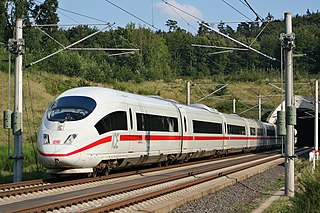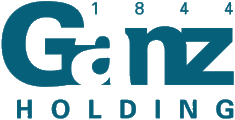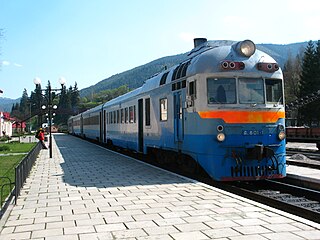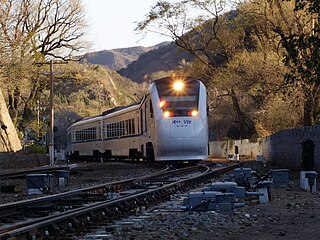
A diesel multiple unit or DMU is a multiple-unit train powered by on-board diesel engines. A DMU requires no separate locomotive, as the engines are incorporated into one or more of the carriages. Diesel-powered single-unit railcars are also generally classed as DMUs. Diesel-powered units may be further classified by their transmission type: diesel–mechanical DMMU, diesel–hydraulic DHMU, or diesel–electric DEMU.

A multiple-unit train or simply multiple unit (MU) is a self-propelled train composed of one or more carriages joined, which when coupled to another multiple unit can be controlled by a single driver, with multiple-unit train control.

A railcar is a self-propelled railway vehicle designed to transport passengers. The term "railcar" is usually used in reference to a train consisting of a single coach, with a driver's cab at one or both ends. Some railway companies, such as the Great Western, termed such vehicles "railmotors".

A railbus is a lightweight passenger railcar that shares many aspects of its construction with a bus, typically having a bus body and four wheels on a fixed base instead of on bogies. Originally designed and developed during the 1930s, railbuses have evolved into larger dimensions with characteristics similar in appearance to a light railcar, with the terms railcar and railbus often used interchangeably. Railbuses designed for use specifically on little-used railway lines were commonly employed in countries such as Germany, Italy, France, the United Kingdom, and Sweden.

The Ganz Machinery Works Holding is a Hungarian holding company. Its products are related to rail transport, power generation, and water supply, among other industries.

The New Zealand EM/ET class electric multiple units were used on suburban services in Wellington, New Zealand from 1982 to 2016. They were owned initially by the New Zealand Railways Corporation and finally by the Greater Wellington Regional Council (GWRC) and operated by Tranz Metro, part of national railway operator KiwiRail.

The DF8 is a type of diesel locomotive used in China. It was in production from 1984 until mid-1990s, with mass production starting in 1989. The revised DF8B is still in production today. DF8 are almost exclusively used for freight services.

D1 (Д1) is a 4-car diesel multiple unit train built in 1960s-1980s by Hungarian producer Ganz-MAVAG for Soviet railways.

The RÁBA Automotive Group, commonly known as Rába, is a Hungarian public limited company, listed on the Budapest Stock Exchange. Rába engineers, manufactures and customizes automotive components, specialty vehicles and axles for commercial vehicles, agri-machinery and earth-movers. The Rába has been building axles as well as complete vehicles since 1902. The company has three strategic business units. The company is headquartered in Győr, employing more than 2000 people.

The Ganz MFAV, known in official BKV records as Mfav., and alternatively known as FAV, or MillFAV, is a type of metro car which was manufactured by Hungarian companies Ganz-MÁVAG Mozdony-, Vagon- és Gépgyár and Ganz Villamossági Gyár. The MFAV metro cars are articulated, 8-axle rail motor coaches with an unusual 2'Bo'Bo'2'tr axle arrangement. They are not capable of operating as electric multiple units. The cars were manufactured in Budapest between 1971 and 1973 and in 1987, and including the two prototype cars, in overall 23 units were made.

The CR200J Fuxing is a Chinese higher-speed trainset consisting of a power car paired with unpowered passenger cars operated by China Railway. It is the slowest member of the Fuxing series. The train was jointly designed and produced by six companies under CRRC.

The DDJ1 is a first generation high-speed electric multiple unit built for China Railway, built by Zhuzhou Electric Locomotives, Changchun Railway Vehicles, Sifang Railway Vehicles, Tangshan Passenger vehicle factory, Nanjing Puzhen and developed by Zhuzhou Electric Locomotive Research Centre. It was built in 1999, and was an experimental vehicle, with only one set built, as it did not enter mass production. The design was well received as part of national science in the 9th five year plan. The DDJ1 is in a push–pull configuration, with only one locomotive in the set and the other end being a trailer with a driver's cabin.

The NZJ "Lushan", also registered as the NZJ1 are a class of diesel multiple unit (DMU) of China Railway. These sets were built by Tangshan Locomotive in a 2M2T layout of four cars with Cummins diesel engines and Siemens electrical equipment. Three sets were built in total between 1998 and 2000, with two operated by Nanchang Railway Bureau and one by Kunming Railway Bureau.

The DJF2"Xianfeng" electric multiple unit is a model operated formerly by China Railway with traction motors distributed throughout the unit. It was developed in 2001 as a key task of the science and technology targets of the Ninth Five-Year Plan. It was an innovative and advanced design being the first Chinese multiple unit train to achieve 200 km/h (124 mph) and achieving a top test speed of 292.8 km/h (181.9 mph) in tests, but had numerous flaws in the design that complicated operations.

The NDJ3 "Great Wall", previously labeled the "Harmony Great Wall" is the only higher-speed diesel multiple unit that is still operating in China. It was first designed to be used for passenger transport in the 2008 Olympics, and has become a mature technology platform with export orders to Nigeria despite initial flaws related to overheating of electrical cables in the power car.

The Dongfeng diesel multiple unit, also known as the Dongfeng motor coach, and NM1, was a DMU of Ministry of Railways, and was also the first diesel-hydraulic power car and double deck passenger car of China, built by Qingdao Sifang in 1958. The train consisted two motors and four double deck trailers, and was designed for short, commuter services. Each motor has two DV12A high speed diesel engines, and has the SF2006-1 hydraulic transmission. As the set had numerous flaws, it never entered mass production, but the valuable experience gained in the design and manufacturing process was later applied to the DFH1 and Red Star-class locomotive, while the passenger cars designs were later further developed for double deck trains such as the NZJ.
The TSD09 diesel multiple unit is a tilting train developed by Tangshan Locomotive in 2003 and fitted with Cummins diesel engines, Voith hydraulic transmission and Extel Systems Wedel tilting mechanisms. It was built for Sanmao Railway, but due to strategic reasons within the Ministry of Railways, the set never operated commercially and has been permanently stored at Tangshan Locomotive.
The KDZ1 is the first electrical multiple unit built in China. It is an experimental alternating current electrical multiple unit, developed by Changchun Railway Vehicles, CRRC Zhuzhou Institute and China Academy of Railway Sciences in 1978 and completed in 1988, though it never saw passenger service, with it being stored after it completed its initial tests.

The DJF1 "Zhongyuan Star" was an electric multiple unit of China Railway. It only operated in service for less than five years, before it was removed from service due to its various flaws and high maintenance costs. The train was initially built as a six car set, and subsequently lengthened to a fourteen car set. The two driving motors and the middle two motor cars have been preserved, with the other carriages being scrapped.

The KDZ1A "Chuncheng" was an early attempt at building an electric multiple unit in China with the participation of Changchun Railway Vehicles, Zhuzhou Institute and Kunming railway bureau. Development was completed in 1999 in time for the Kunming World Horticultural Exposition. As its predecessor, the KDZ1 never operated commercially, the KDZ1A became the first Chinese EMU to be in revenue service, although it was in service for only 10 years before being withdrawn.


















